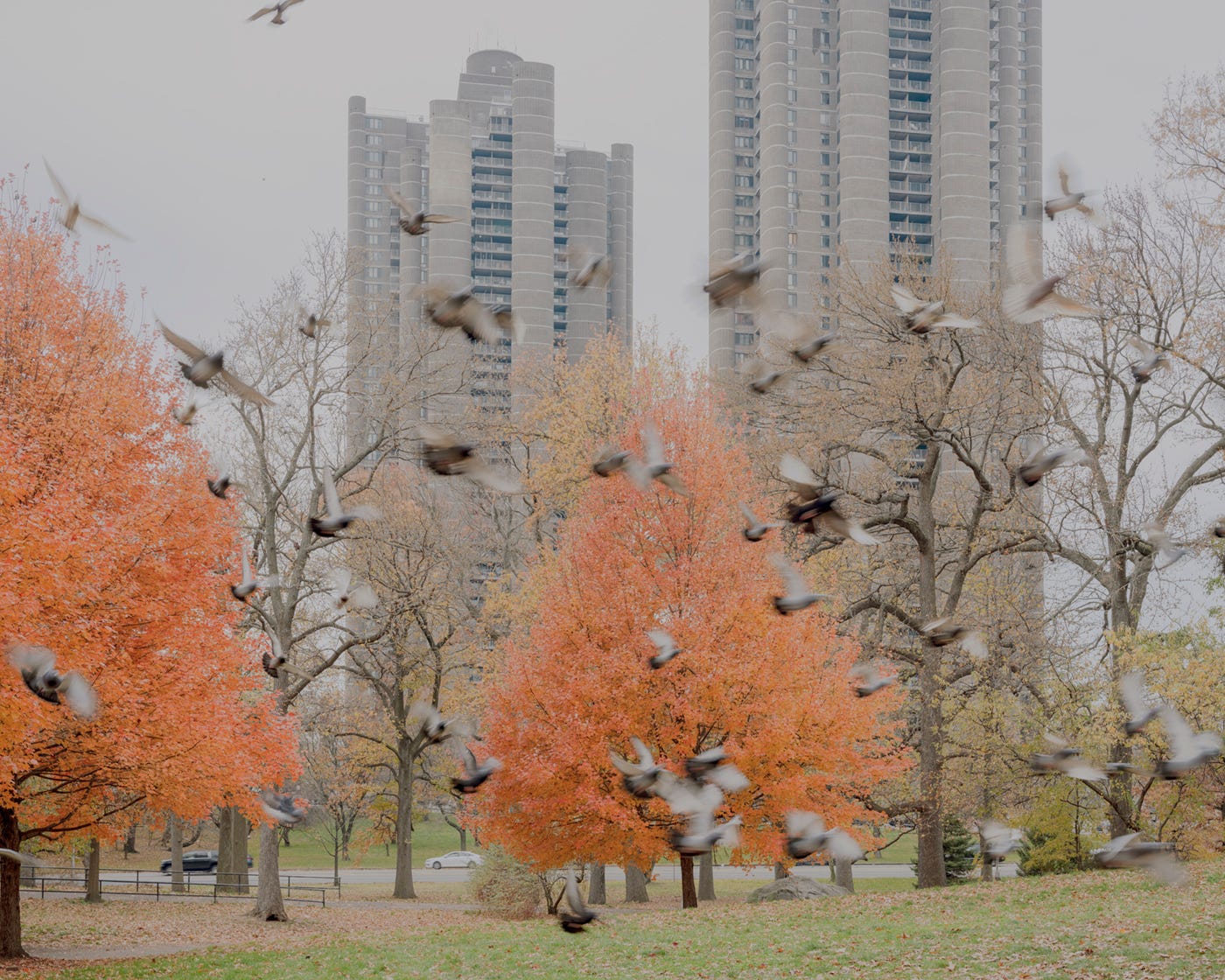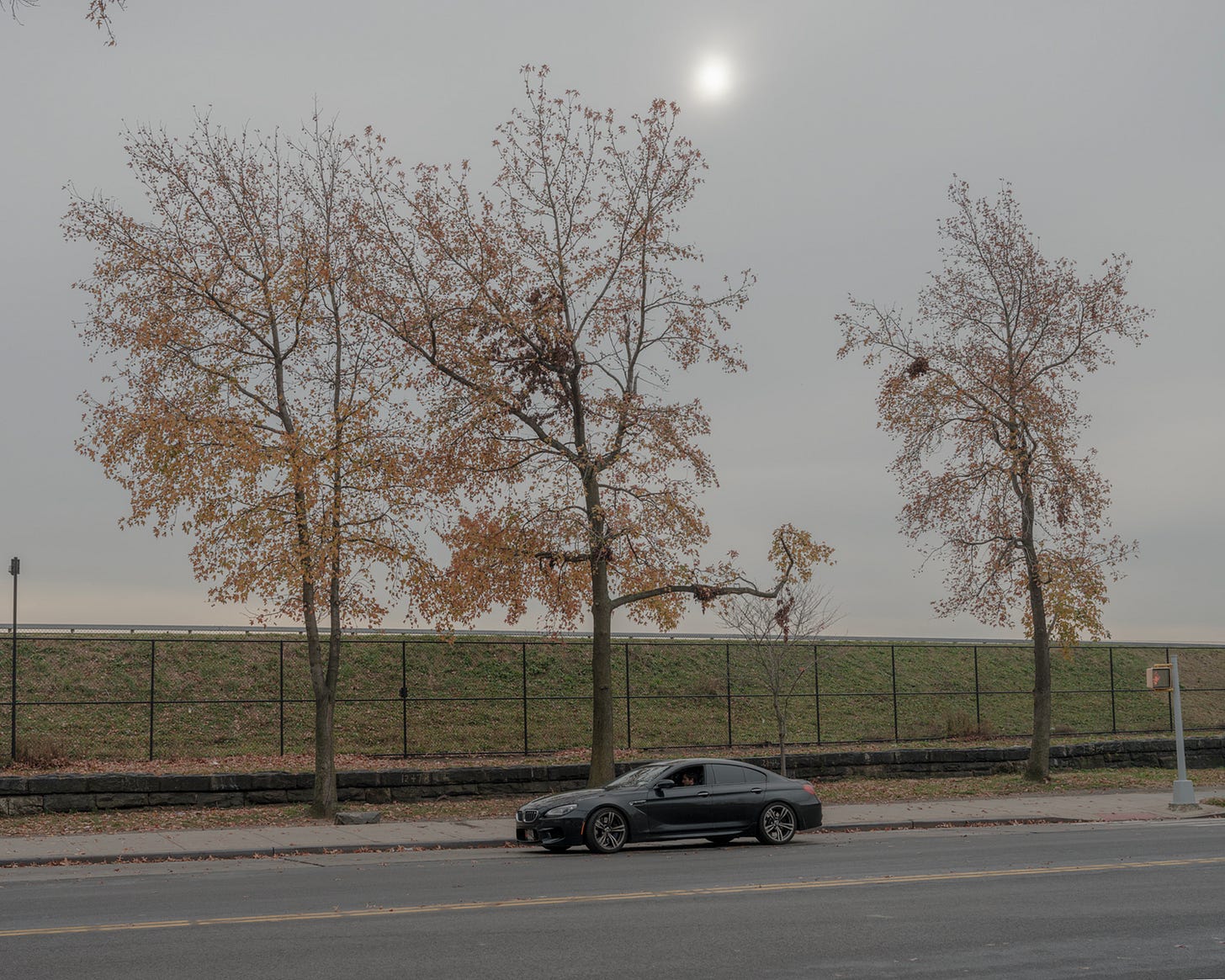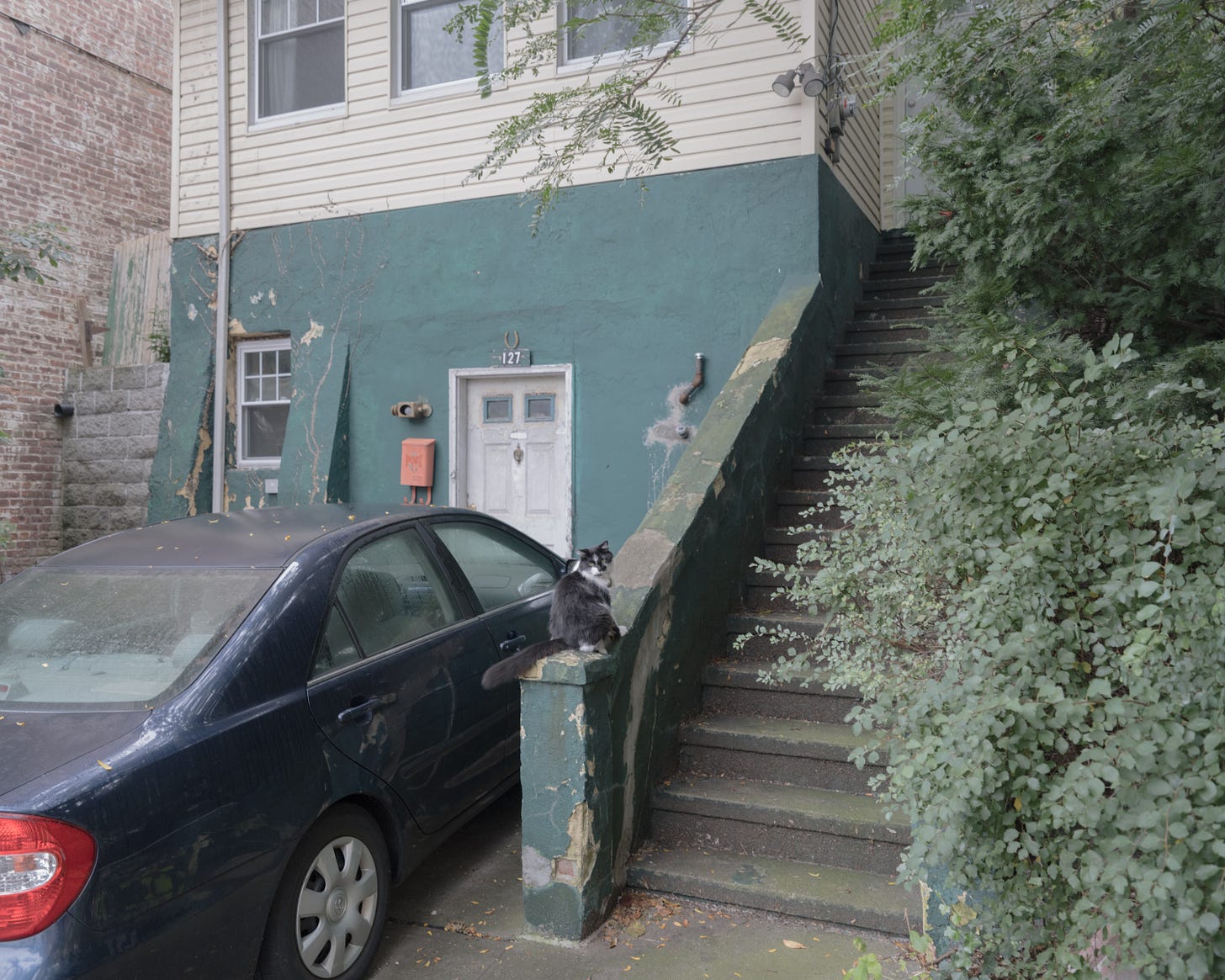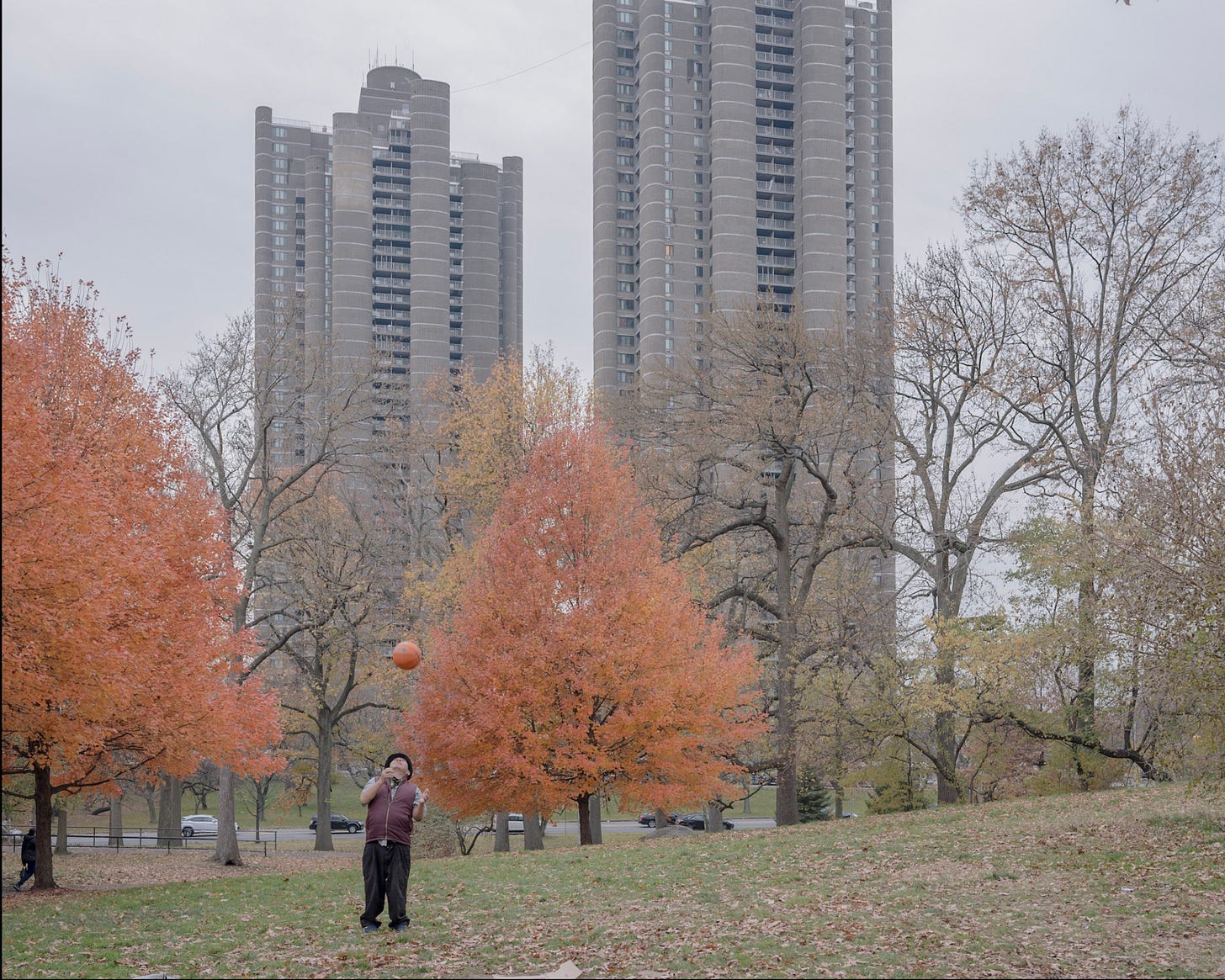The King’s Bridge was Manhattan’s first built connection to the mainland, crossing from Marble Hill over Spuyten Duyvil Creek and landing in the neighborhood now known as Kingsbridge. This week, the newsletter set its sites just a little bit higher to Kingsbridge Heights, which comes by its name honestly, rising steeply up from the west side of the Major Deegan Expressway. Kingsbridge Heights’ 300 acres are striated by a series of step-streets, a necessary way for pedestrians to navigate the neighborhood’s vertiginous topography.
Besides the Deegan, other borders are formed by Jerome Ave to the west, Van Cortlandt Park to the North, and Kingsbridge Road to the south.
Right smack in the middle sits the 94-acre Jerome Park Reservoir, holding nearly 10% of the city’s water supply. The reservoir’s deep blue waters are tantalizingly close but completely inaccessible, guarded by a 10ft high chain link that runs along its entire 2.2 mile perimeter.
The reservoir sits on land formerly occupied by the Jerome Park Racetrack, built in 1866 by Leonard Jerome (Winston Churchill’s grandfather) and August Belmont. The Belmont Stakes, the third leg of the Triple Crown of horse racing, was first held here. The track was closed in 1894 to make way for the reservoir.
While the reservoir was initially built to hold nearly two trillion gallons of water, it was only half completed, leaving the entire freshly excavated east basin of the plot undeveloped. Several large-scale public projects like the Kingsbridge Armory, Bronx High School, Lehman College, and the most visible landmark in the surrounding area, The Tracey Towers, took advantage of the empty space.
TRACEY TOWERS
Described as “sand castles with overactive thyroids” in the AIA Guide to New York City, the Tracey Towers, designed by architect Paul Rudolph, are the Bronx’s second tallest buildings. Rudolph, known for the A & A Building (Rudolph Hall) on the Yale University Campus, clad the towers in a similar bushhammered, courdory-like concrete facade.
The Towers, nine Brutalist columns rising out of the flattened reservoir bed, still feel futuristic despite their 50 years. Surprisingly, their curves are purely decorative, and the apartments themselves are entirely rectilinear, with windows only on the flat walls between the columns and closets tucked into the squared-off corners.
This inversion of the form follows function principle plays out in the building’s public spaces as well.
It is impossible to know where to enter; ramps lead to more ramps, which lead to chain-link fences blocking access to the building’s labyrinthine public spaces. The lobby level is really half a dozen levels, interconnected in ways that even an architecture writer can’t suss out.” (Fred Bernstein, Oculus, 2005)1
The building’s elevators are equally problematic.
STUCK
This is the first part
where the wheels begin to turn,
where the elevator begins its ascent,
before the doors lurch apart.
In 2005, Ming Kuang Chen left the Happy Dragon restaurant with a delivery for an apartment in the Tracey Towers. When he never returned, the police were called. Given the recent spate of murders of Chinese restaurant deliverymen in the area, the response was extreme.
Every one of the towers’ 871 apartments was searched, cadaver-detecting dogs blanketed Van Cortlandt Park while scuba divers plied the dark waters of the reservoir looking for a body. Unfortunately, they forgot to check the elevators.
Mr. Chen, who had paid a smuggler $60,000 to bring him into the US from the Fujian Province in China, was trapped for 81 hours in one of the Tracey Towers’ express elevators, reluctant to pull the alarm due to his immigration status. The elevator had a camera and an intercom that he tried to communicate over but to no avail.
It’s easy to draw a parallel between Mr. Chen’s experiences stuck between the 3rd and 4th floor and that of his life as an undocumented immigrant between the US and China, where his wife and 12-year-old son depended on his paycheck. Shortly after the incident, he moved out of the city to avoid deportation.
In 2013, Stuck Elevator, a musical based around the ordeal by composer Byron Au Yong and playwright Aaron Jafferis, had its world premiere at San Francisco’s American Conservatory Theater.
THE CASTLE OF KINGSBRIDGE
I’ve featured a couple of houses in this newsletter that demonstrate an obvious affinity with Medieval architecture. The crenelated roof lines and turrets of these homes aren’t very convincing, but this house at 2744 Kingsbridge Terrace is an exception.
With its gray stucco facade punctuated by the odd quatrefoil, red gabled roof, and crenelated turrets, this castle/home boasts 11 bedrooms, five bathrooms, seven fireplaces, and an attached two-car garage. This is a home truly fit for a king.
This video from real estate brokers, The Gold Team, is a cult classic. The description of the weather vane as a “copper wind direction determiner” is just one of many high points.
The castle also makes an appearance in another cult classic, The Wanderers (89% on Rotten Tomatoes). The movie, based on Richard Price’s first novel, follows an Italian-American teenage gang, the Wanderers, as they fight rival gangs like the Fordham Baldies and the Wongs.
The outside of the house and the basement both feature prominently in the film.
This is the middle. Things have had time to get complicated, messy, really. Nothing is simple anymore. Cities have sprouted up along the rivers teeming with people at cross-purposes— a million schemes, a million wild looks.
THE TEMPLE OF ENLIGHTENMENT
The Temple of Enlightenment (TOE) boasts one of the more unique facades in the neighborhood. The building, formerly home to a telecommunications company, was converted into the city’s 4th Buddhist temple in 1966.
Even more impressive than the temple’s arching oculus entryway is the holy relics it purportedly contains, two 2,500-year-old bone fragments recovered from the Buddha’s funeral pyre. It’s incredible that this squat red brick building overlooking the Deegan Expressway in the Bronx could contain bits of bone from one of civilization’s major spiritual leaders.
Curiously, these relics are not mentioned on the Temple of Enlightenment website or anywhere else. I only learned about them via a 1972 New York Times article mentioning their transfer. You would think being in possession of Buddha relics would be the kind of thing you would want to advertise if you were a Buddhist temple, but maybe not. There is also the possibility that the relics were later proven to be inauthentic. I reached out to the temple for an update but have yet to hear back.
SIGHTS AND SOUNDS
This week’s audio starts off quietly but quickly builds to a cacophonous din courtesy of an elevated train, a street sweeper, and an Ehru (Chinese fiddle) solo.
Amazingly, Shazam, the app that can identify music after hearing a few seconds of a recording, was able to ascertain that the busker’s backing track was Moon Reflection in the Er Quan by Peng Liyuan.
FEATURED PHOTOGRAPH(ER)
I wasn’t having much luck finding photographs of Kingsbridge Heights until I searched the Library of Congress website for Tracey Towers. These images are attributed to the architect Paul Rudolph. I’m not sure if he took the pictures or commissioned them, but regardless, the recently constructed buildings look particularly futuristic in these unpeopled pictures. Flaws in several of the transparencies only add to the retrofuturistic effect.
NOTES
This sped-up and dramatically scored security footage shows Nicholas White’s weekend trapped in an elevator in the McGraw Hill building in 1999. White went out for a cigarette break and, on his way back, got stuck in an express elevator for forty-one hours. Now imagine enduring that for twice as long while simultaneously worrying if and when you finally do get rescued, you may be deported.
Nick Paumgarten wrote a fascinating piece for the New Yorker on Nicholas White’s ordeal and the elevator industry in general.
Both Nicholas and Ming Kuang Chen could have benefited from an elevator inspector like Lila Mae Watson, the protagonist in Colson Whitehead’s first novel, The Intuitionist.
I once got stuck in an elevator on my way to work. The alarm was inaudible. The emergency call button went to a disconnected number. I eventually reached someone on my cell phone and was freed 45 minutes later. Sadly, the lentil soup I had picked up for my lunch leaked through the bag onto the elevator floor. I haven’t brought soup to work since.
The Kingsbridge Armory was built between 1912 and 1917 for munitions storage. It is frequently referred to as "possibly the largest armory in the world. You would think there would be a definitive answer to this, but it is still up for debate. In any event, it is massive.
The military left in 1996, and the building was turned over to city management. Proposals to convert the armory into a mall, a homeless shelter, and the world's largest indoor ice rink have all come and gone. Today, all the action is on the outside, where the sidewalk functions like an open-air market, and the armory fence serves as a perfect place to display the myriad of pants, puffer coats, and t-shirts offered for sale.
For all you Brutalism fans out there, bushhammering, according to Concrete Construction magazine, is “the use of tools to remove mortar and fracture aggregate at an exposed concrete surface. The amount of removal can vary significantly, depending on the application.”2
Billy Collins, Poet Laureate of the United States from 2001 to 2003, was a Professor at Lehman College in Kingsbridge Heights for 30 years. His poem Aristotle is excerpted throughout this week’s newsletter.
And this is the end, the car running out of road, the river losing its name in an ocean, the long nose of the photographed horse touching the white electronic line. This is the colophon, the last elephant in the parade, the empty wheelchair, and pigeons floating down in the evening
http://www.archnewsnow.com/features/Feature180.htm
https://www.concreteconstruction.net/how-to/bushhammering_o














































Nothing finer than some Kingsbridge crenellations.
Well done.
Hmm—for those of us who live here, it’s usually Bailey that is the border, as it pre-dates the Deegan. The Temple of Enlightenment is generally considered Kingsbridge proper, as is that terrible motel, although I’m inclined to give you that one! It’s really once you get into the hills east of Bailey that you are properly in the “heights” of Kingsbridge—similarly on the west, our border is Irwin, which is the base of the Riverdale hill.